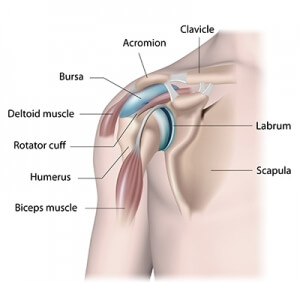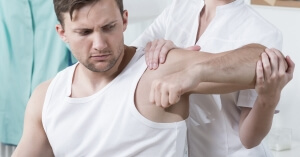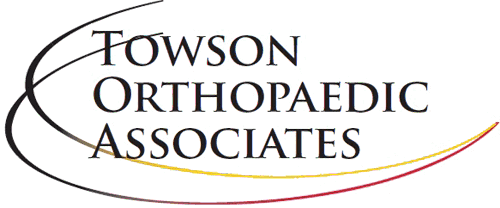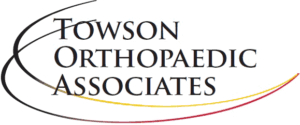 The rotator cuff is a group of muscles, which come together as tendons to attach the humerus (upper arm bone) to the shoulder blade. Not only does the rotator cuff hold the arm in the shoulder socket, it also provides the ability to lift and rotate the arm. When the rotator cuff is torn, pain and weakness in the shoulder can make simple everyday tasks, such as combing your hair or getting dressed, extremely difficult.
The rotator cuff is a group of muscles, which come together as tendons to attach the humerus (upper arm bone) to the shoulder blade. Not only does the rotator cuff hold the arm in the shoulder socket, it also provides the ability to lift and rotate the arm. When the rotator cuff is torn, pain and weakness in the shoulder can make simple everyday tasks, such as combing your hair or getting dressed, extremely difficult.
If left untreated, a rotator cuff tear can enlarge, making repairs more difficult. It may also lead to long term shoulder issues. If you’re experiencing ongoing pain or weakness in the shoulder, it’s important to seek treatment as soon as possible to avoid irreparable damage to the joint.
What is a Rotator Cuff Tear?
According to the American Academy of Orthopaedic Surgeons, “Each year, almost 2 million people in the United States visit their doctors because of a rotator cuff problem.”
What causes a torn rotator cuff?
There are two main causes of rotator cuff tears:
Degenerative tears: Most rotator cuff tears are caused by regular wear and tear on the tendons. Since this degeneration occurs naturally as we age, the risk increases as we pass the age of 50. However, other factors can lead to weakening of the tendons including bone spurs (shoulder impingement) or repetitive motion.
Acute Tears: A smaller percentage of tears are caused during a traumatic injury, such as a fall or lifting a heavy object. These tears can often occur with another injury, such as a dislocated shoulder. Weakness is a common complaint of these patients.
What are the different types of rotator cuff tears?
A partial tear (incomplete tear) occurs when there is damage to the tendon, but it remains connected to the bone.
A full-thickness tear (complete tear) occurs when the tendon is completely separated from the bone.
Symptoms of a Rotator Cuff Tear
How can I tell if I tore my rotator cuff?
While acute rotator cuff tears often cause immediate, intense pain and weakness in the arm, symptoms of a degenerative tear may appear slowly and increase over time.
Common symptoms of a rotator cuff tear include:
- Pain at rest and during sleep
- Pain when lifting and lowering the arm
- Weakness in the shoulder
Note: Not all rotator cuff tears are painful. Any weakness in the shoulder, even without pain, should be examined as soon as possible to prevent symptoms from worsening.
Rotator Cuff Tear Diagnosis
 How is a rotator cuff injury diagnosed?
How is a rotator cuff injury diagnosed?
A rotator cuff tear diagnosis begins with understanding the type and location of the pain in the shoulder. Examining a patient’s shoulder allows the doctor to test each rotator cuff muscle for weakness, signs of bursitis, and global function of the shoulder. Imaging such as X-rays can provide an easy way to confirm the alignment of the shoulder as well as the presence of shoulder arthritis.
If there are abnormalities, advanced imaging techniques such as an MRI can often provide a clear picture of rotator cuff health. It can also give an idea about how long the rotator cuff has been torn as well as detail the labrum, cartilage, and bone spurs.
Rotator Cuff Tear Treatment
The best treatment for a rotator cuff injury depends on a variety of factors including the severity of the tear, patient age, and activity level. For many patients with a partial-thickness tear, nonsurgical treatment can successfully relieve pain and restore mobility to the shoulder.
Nonsurgical treatment options include:
- Limiting activities that irritate the shoulder
- Non-steroidal anti-inflammatory medications (NSAIDs)
- Physical therapy or a home exercise program
- Cortisone injections
When a tear does not respond to non-surgical methods, arthroscopic surgery may be recommended to fully evaluate the tendon tear, repair damage, and smooth down bone spurs using a process called an “acromioplasty.”
Rotator Cuff Repair
Large tears and tears that continue to cause pain often require arthroscopically repair to decrease pain and improve function to the shoulder and arm. This can be done minimally invasively using a variety of techniques including:
- Single-row or double-row fixation techniques
- Rotator cuff augmentation patches
Rotator Cuff Reconstruction
In patients with massive tears that have been present for a long time, the tears can scar down and may be irreparable. In this case, a complete reconstruction of the tendon and the underlying shoulder capsule is often necessary to improve shoulder function. The surgeons at Towson Orthopaedics are fellowship-trained in these advanced rotator cuff reconstruction techniques, which include:
Superior capsular reconstruction (SCR)
Given that the rotator cuff and the superior shoulder capsule sits on top of the shoulder to help with lifting your arm overhead, massive rotator cuffs are lacking these structures. Research studies have found that patients who have a donor tissue rebuild this layer have improved shoulder function and pain relief. Although there are limitations to this highly specialized technique, it allows our patients an improved quality of life when there were no options just ten years ago.
Tendon transfers
Tendon transfers are another option that allow some patients, who are not good candidates for a superior capsular reconstruction to improve their function. This surgery optimizes the pull of certain tendons in the torso to mimic that of the injured rotator cuff tendons.
- Pectoralis major transfer
- Latissimus dorsi tendon transfer
- Trapezius transfer
Shoulder Replacement / Arthroplasty
The goal of any treatment, with or without surgery, is to improve your shoulder function, relieve pain and preserve the long-term function of your shoulder. When the above-listed techniques are no longer able to provide a reliable outcome, the experts at Towson Orthopedics have specialized training in shoulder replacement such as the reverse shoulder replacement. This procedure, which has been performed and perfected over the past decades, uses the design of the prosthesis to improve shoulder function and pain.




